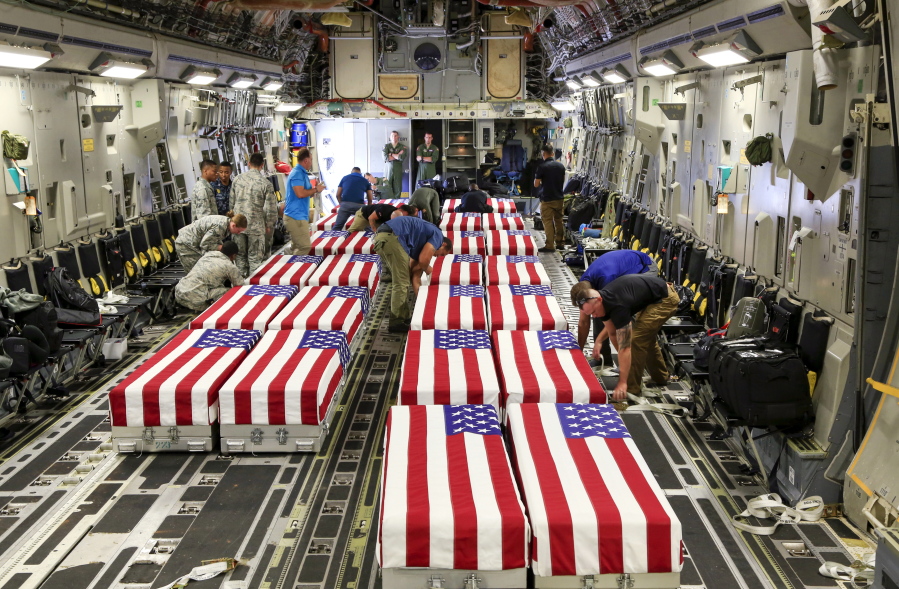BELLEVUE, Neb. — Nearly 77 years after repeated torpedo strikes tore into the USS Oklahoma, killing hundreds of sailors and Marines, Carrie Brown leaned over the remains of a serviceman laid out on a table in her lab and was surprised the bones still smelled of burning oil from that horrific day at Pearl Harbor.
It was a visceral reminder of the catastrophic attack that pulled the United States into World War II, and it added an intimacy to the painstaking work Brown and hundreds of others are now doing to greatly increase the number of lost American servicemen who have been identified.
It’s a monumental mission that combines science, history and intuition, and it’s one Brown and her colleagues have recently been completing at ramped-up speed, with identifications expected to reach 200 annually, more than triple the figures from recent years.
“There are families still carrying the torch,” said Brown, a forensic anthropologist with the Defense POW/MIA Accounting Agency’s lab near Omaha, Neb. “It’s just as important now as it was 77 years ago.”
Officials believe remains of nearly half of the 83,000 unidentified service members killed in World War II and more recent wars could be identified and returned to relatives. The modern effort to identify remains started in 1973 and was primarily based in Hawaii until a second lab was opened in 2012 at Offutt Air Force Base in the Omaha suburb of Bellevue.
With an intensified push, the identifications climbed from 59 in 2013 to 183 last year and at least 200 and possibly a few more this year.
The increase has led to a surge of long-delayed memorial services and burials across the country as families and communities turn out to honor those killed.
Joani McGinnis, of Shenandoah, Iowa, said her family is planning a service Friday at the national cemetery in Omaha now that they have finally learned what happened to her uncle, Sgt. Melvin. C. Anderson.
Piecing together bits of history and DNA, the Omaha lab confirmed that remains found in 1946 in Germany were Anderson’s and that he died when his tank was hit in the rugged Hurtgen Forest during a battle that lasted months and left tens of thousands of Americans killed and wounded.
Besides returning the remains, McGinnis said the agency gave her a thick file with details about how he died and how researchers unraveled the mystery.
“I wish my mom and my grandma were here to know all this information,” said McGinnis, who recalled a framed picture of Anderson that hung in her grandmother’s home in Omaha. “My grandmother was very sad about it. She just wanted to know what happened, and she never knew.”
In Kentucky, thousands of people lined roads for miles on a steamy August day to see a hearse carrying the remains of Army Pfc. Joe Stanton Elmore from the Nashville, Tenn., airport to the small city of Albany.
Elmore was reported missing in action in December 1950 after an intense battle at the Chosin Reservoir in Korea and as deceased in 1953, but his great-niece April Speck said even decades later, her family would tell stories of “Joe going off to war and never coming home.” Speck said she knew her family would feel a sense of relief that his remains were finally returned, but she didn’t realize what it would mean to her community.
“There were people standing out with their signs and there were retired soldiers in their uniforms saluting, and then we get into Albany and it was like a sea of people with all the American flags,” she recalled. “The county did an awesome job of showing respect.”
The soaring number of identifications followed years of complaints about a cumbersome process, typically resulting in about 60 completed cases annually. Congress responded by setting a goal of 200 identifications annually, and it supported a reorganization and increased funding that saw spending climb from $80.8 million in the 2010 fiscal year to $143.9 million in 2018.
The effort now employs about 600 people.
Officials have streamlined the work of determining which remains should be disinterred. Historians focus on where clusters of servicemen died, and examine troop movements and conduct interviews with local residents.
“This work is very different from what most historians do,” said Ian Spurgeon, an agency historian in Washington. “This is detective history.”



